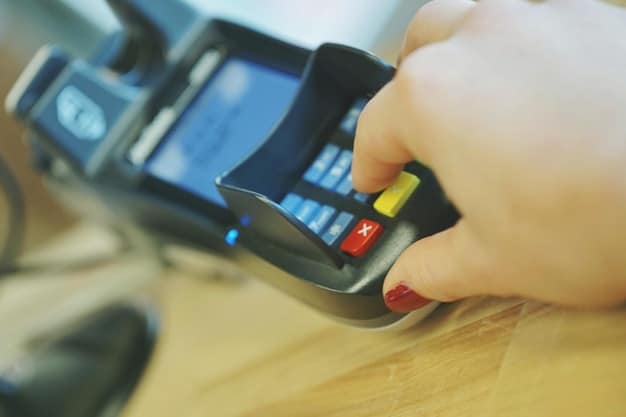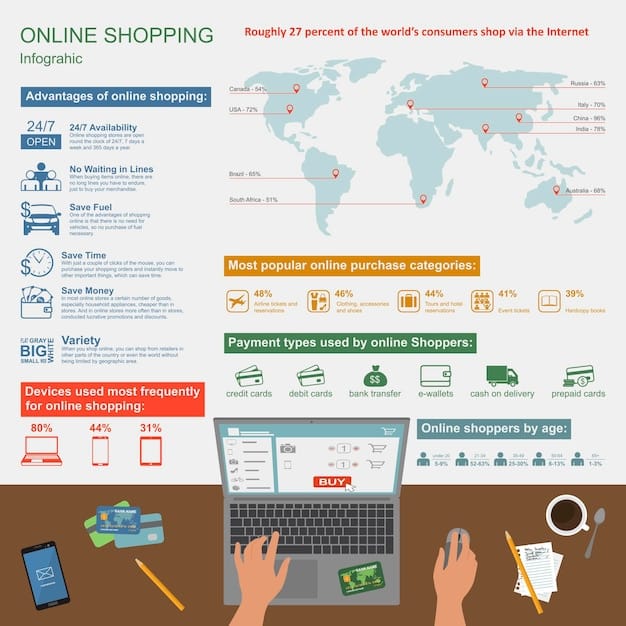EMV Chip Card Technology: Navigating Fraud Liability Shifts in 2025 for US E-commerce

EMV Chip Card Technology: What US E-commerce Businesses Need to Know About Fraud Liability Shifts in 2025 focuses on the impending changes in fraud liability, urging businesses to adopt EMV chip card technology to mitigate risks associated with fraudulent transactions and ensure compliance.
The landscape of e-commerce is constantly evolving, and with it, so are the methods of fraud. For US e-commerce businesses, staying ahead of these changes is crucial, especially as we approach 2025. A key area of focus is EMV Chip Card Technology: What US E-commerce Businesses Need to Know About Fraud Liability Shifts in 2025. Understanding the implications of this shift is paramount to protecting your business and your customers. This article will delve into the specifics, offering actionable insights and guidance.
Understanding EMV Chip Card Technology and Its Role
EMV chip card technology, initially designed to combat in-store fraud, has a growing significance for e-commerce. As fraudsters adapt to bypass traditional security measures online protecting customer data becomes paramount.
What is EMV Chip Card Technology?
EMV (Europay, MasterCard, and Visa) chip card technology utilizes a microchip embedded in credit and debit cards. This chip generates a unique, dynamic code for each transaction, making it significantly more difficult for fraudsters to counterfeit cards or steal card data. While primarily used in physical stores, its principles are relevant to online security, influencing authentication and fraud prevention strategies for the digital world.
The Benefits of EMV Chip Card Technology
- Reduced Counterfeit Card Fraud: The dynamic codes make it harder to create fake cards.
- Enhanced Security: EMV cards offer better protection against skimming and data theft compared to magnetic stripe cards.
- Global Standard: EMV is widely adopted worldwide, making transactions more secure across borders.
Therefore, mastering EMV Chip Card Technology: What US E-commerce Businesses Need to Know About Fraud Liability Shifts in 2025 is essential. Not only for regulatory compliance but also for creating a secure and positive experience for your customers. Protecting customer’s data is invaluable as it encourages potential customers to become returning consumers through online purchases, creating a strong, reputable brand.

The 2025 Fraud Liability Shift: What It Means for E-commerce
The impending fraud liability shift in 2025 is a crucial consideration for businesses. This shift in liability means that merchants who do not support EMV chip card technology for online transactions may become liable for fraudulent charges.
Understanding the Liability Shift
The liability shift is designed to incentivize merchants to adopt more secure payment methods. If a fraudulent transaction occurs and the merchant hasn’t implemented EMV-compliant technology, they may be held responsible for the financial losses. This will drastically help combat the methods of fraudulent activities in the coming years as the EMV technology becomes more up to date than traditional methods.
How the Shift Impacts US E-commerce Businesses
US e-commerce businesses are especially vulnerable to this shift because traditional magnetic stripe cards are still widely used. As fraudsters target online transactions, those businesses that haven’t adopted EMV chip card technology will increasingly be targeted. Not only does fraudulent activity cause financial damage but it also decreases the trust of consumers.
Preparing for the Shift
Preparing for the fraud liability shift involves updating payment processing systems to support EMV chip card technology. This includes implementing additional security measures, as well as educating consumers and employees about online safety. As technology advances over time, so do the methods of fraudulent activity – the implementation of EMV technology is vital to the health of payment processing.
The implementation of EMV Chip Card Technology: What US E-commerce Businesses Need to Know About Fraud Liability Shifts in 2025 is an investment in the security and reputation of your business. By understanding and preparing for the 2025 fraud liability shift, e-commerce businesses can protect themselves financially and maintain the trust of their customers. Having a good reputation is a great first impression to potential consumers that they feel they can return to for continuous purchases and trust.
Implementing EMV Chip Card Technology in Your E-commerce Platform
Implementing EMV technology in e-commerce involves a multifaceted approach. Enhancing security measures and aligning technological infrastructure is vital step forwards for merchants.
Choosing the Right Payment Gateway
Selecting a payment gateway that supports EMV chip card technology is the first step. Look for gateways that offer tokenization, encryption, and other security features. This is a vital step and should be viewed with utmost importance as it will significantly deter methods of fraudulent activity over time.
Secure Customer Authentication
Implement strong customer authentication methods, such as two-factor authentication (2FA) and address verification systems (AVS). Additionally, consider using 3D Secure protocols like Visa Secure and Mastercard Identity Check. This ensures a secure way of making payments online and lessens future worries, allowing more time to focus on other aspects of day to day operations of maintaining your brand.
Employee and Customer Education
Educate employees and customers about the new security measures. Provide clear instructions on how to use EMV chip cards for online transactions and promote safe online shopping habits. Make sure information is clear, concise and covers a multitude of aspects of the technologies to ensure all information is retained and used with positive affects on future payment endeavours.

Best Practices for Fraud Prevention in E-commerce
In addition to installing EMV chip card technology, implementing a strong business practice to deter fraudulent activity is vital. Combining technology and smart business management ensures the best protection against fraud.
Regular Security Audits
Conduct regular security audits to identify vulnerabilities and weaknesses in your e-commerce platform. Stay informed about the risks of your business by continuously assessing them. The more knowledge obtained, the easier it is to counter-act potential harm that fraudulent activity can cause on your business, keeping it healthy. With proper knowledge on EMV Chip Card Technology: What US E-commerce Businesses Need to Know About Fraud Liability Shifts in 2025 you can take precautions regarding future safety risks.
Monitoring Transactions
Implement systems to monitor transactions for suspicious activity. Look for patterns such as multiple transactions from the same IP address or high-value purchases made with newly created accounts. Always have multiple layers of monitoring to stay on top of any possible issues that might arise from fraudulent activities.
Staying Updated on Fraud Trends
Stay informed about the latest fraud trends and adapt your security measures accordingly. Fraudsters are constantly evolving their tactics, so it’s important to stay one step ahead. The better you are at predicting, reviewing and protecting, the better your business will be when handling such events.
Putting resources towards protection and understanding the complexities of EMV Chip Card Technology: What US E-commerce Businesses Need to Know About Fraud Liability Shifts in 2025 is paramount to your business’s health. Ensuring the safety for your customers and business itself is the most vital step towards the future of your brand.
The Future of Payment Security in E-commerce
The future of payment security in e-commerce is set to be defined by technological improvements and the rise of new payment methods. Staying flexible and open to change is key to being ready for any future improvements. Constant assessment creates room for growth and adaptation for all future endeavours.
The Rise of Biometric Authentication
Biometric authentication, such as fingerprint scanning and facial recognition, is becoming more common for online transactions. These methods provide an extra layer of security by verifying the identity of the cardholder. Combining this security method with EMV technology could greatly change the future of the security in payments.
Blockchain Technology
Blockchain technology offers secure and transparent transaction processing. While still in its early stages, blockchain has the potential to revolutionize payment security by eliminating intermediaries and reducing the risk of fraud. Improving this method, with EMV, could change the future for payment processing security.
AI and Machine Learning in Fraud Detection
Artificial intelligence (AI) and machine learning (ML) are increasingly used to detect fraudulent transactions in real-time. These technologies can analyze massive amounts of data to identify suspicious patterns and prevent fraud before it occurs. Incorporating AI with EMV Chip Card Technology: What US E-commerce Businesses Need to Know About Fraud Liability Shifts in 2025 can further protect your business and customer from fraudulent activity.
The world of technology is constantly evolving and changing as new opportunities present themselves. By being proactive and prepared, you can ensure the future safety for your business and your customers. Therefore, learning about EMV Chip Card Technology: What US E-commerce Businesses Need to Know About Fraud Liability Shifts in 2025 is a great step in the right direction.
| Key Aspects | Brief Description |
|---|---|
| 🛡️ EMV Chip Security | Enhances fraud protection with dynamic transaction codes. |
| ⚖️ Liability Shift | Non-compliance may result in liability for fraudulent charges. |
| ✅ Payment Gateway | Choose gateways supporting EMV and strong authentication. |
| 🤖 Future Trends | Biometrics, Blockchain, AI offer enhanced security. |
Frequently Asked Questions
The 2025 fraud liability shift aims to encourage US e-commerce businesses to adopt more secure payment methods, such as EMV chip card technology, to reduce fraudulent transactions and protect both businesses and consumers.
EMV chip cards generate a unique, dynamic code for each transaction, making it significantly harder to counterfeit cards or steal card data compared to the static data stored on magnetic stripe cards.
Businesses should upgrade payment processing systems, implement strong customer authentication methods, educate employees and customers, and stay informed about the latest fraud trends to prepare for the shift.
E-commerce sites can implement two-factor authentication (2FA), address verification systems (AVS), and 3D Secure protocols like Visa Secure and Mastercard Identity Check to enhance security.
AI and machine learning analyze vast amounts of transaction data in real-time to identify suspicious patterns and prevent fraud, providing an additional layer of security in conjunction with EMV chip card technology.
Conclusion
In conclusion, the EMV Chip Card Technology: What US E-commerce Businesses Need to Know About Fraud Liability Shifts in 2025 presents both challenges and opportunities for US e-commerce businesses. By understanding the technology, adopting proactive security measures, and staying informed about emerging trends, businesses can protect themselves and their customers from fraud.





